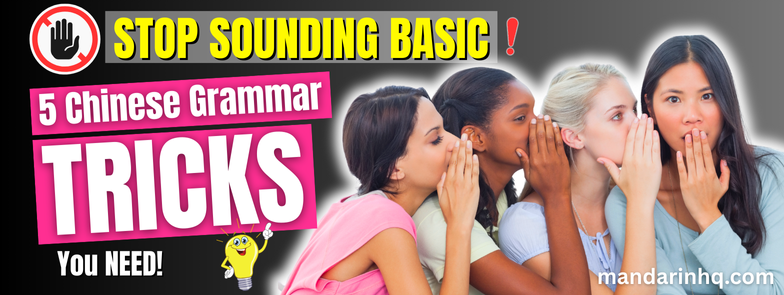Learning Chinese is exciting—but once you move beyond simple sentences like “我喝咖啡” (wǒ hē kāfēi – I drink coffee) or “我是老师” (wǒ shì lǎoshī – I am a teacher), it’s time to add depth and fluency to your speaking and writing. Native speakers don’t just speak in basic subject-verb-object patterns—they use a range of sentence structures to express actions, emotions and and more.
In this lesson, you’ll learn 5 powerful Chinese sentence patterns that will make your speech sound more natural and confident.
If you want to move beyond basic sentences and sound more fluent, then the 5 sentence patterns from this lesson are a good place to start.
 1. 把 Sentences — Emphasize What Happens to the Object
1. 把 Sentences — Emphasize What Happens to the Object
In a standard Chinese sentence, the word order is Subject + Verb + Object.
But with 把 (bǎ), we bring the object forward to highlight what’s being done to it.
 Structure:
Structure:
Subject + 把 + Object + Verb + Complement
 Example:
Example:
我把手机放在桌子上了。
wǒ bǎ shǒujī fàng zài zhuōzi shàng le
→ I put the phone on the table.

- The object is known
- You’re doing something specific to it

More examples:
他们把问题解决了。
tāmen bǎ wèntí jiějué le
→ They solved the problem.
妈妈把衣服洗好了。
māmā bǎ yīfu xǐ hǎo le
→ Mom washed the clothes.
 2. 被 Sentences — Express the Passive Voice
2. 被 Sentences — Express the Passive Voice
Use 被 (bèi) when something is done to someone, especially in negative situations.
 Structure:
Structure:
Subject + 被 + Agent + Verb + 了
 Example:
Example:
他被老师批评了。
tā bèi lǎoshī pīpíng le
→ He was criticized by the teacher.

More examples:
他的钱包被人偷了。
tā de qiánbāo bèi rén tōu le
→ His wallet was stolen.
我被蚊子咬了。
wǒ bèi wénzi yǎo le
→ I was bitten by a mosquito.
 3. 一边…一边… — Talk About Two Actions Happening at Once
3. 一边…一边… — Talk About Two Actions Happening at Once
Doing two things at the same time? This pattern is perfect!
 Structure:
Structure:
Subject + 一边 + Verb A, 一边 + Verb B
 Example:
Example:
我一边吃饭,一边看电视。
wǒ yìbiān chīfàn, yìbiān kàn diànshì
→ I’m eating while watching TV.
More examples:
他一边走路,一边打电话。
tā yìbiān zǒulù, yìbiān dǎ diànhuà
→ He is walking while talking on the phone.
我们一边聊天,一边喝茶。
wǒmen yìbiān liáotiān, yìbiān hē chá
→ We’re chatting while drinking tea.
 4. 除了…以外 — Say "Except for" or "In Addition to"
4. 除了…以外 — Say "Except for" or "In Addition to"
This useful pattern helps you exclude or add information.
 Two ways to use it:
Two ways to use it:
- 除了 A 以外,Subject 都 + Verb → Except for A…
- 除了 A 以外,Subject 也 + Verb → In addition to A…
 Examples:
Examples:
除了他以外,我们都去了。
chúle tā yǐwài, wǒmen dōu qù le
→ Except for him, we all went.
除了中文以外,我也学法语。
chúle zhōngwén yǐwài, wǒ yě xué fǎyǔ
→ In addition to Chinese, I also study French.
More examples:
除了星期天以外,我每天都上班。
chúle xīngqītiān yǐwài, wǒ měitiān dōu shàngbān
→ Except for Sunday, I work every day.
除了踢足球以外,他也喜欢打篮球。
chúle tī zúqiú yǐwài, tā yě xǐhuan dǎ lánqiú
→ In addition to playing soccer, he also likes playing basketball.


 5. 越…越… — The More…, The More…
5. 越…越… — The More…, The More…
This is one of the most native-sounding ways to express increasing intensity or cause-effect in Chinese.
 Structure:
Structure:
Subject 1 + 越 + Verb/Adj, Subject 2 + 越 + Result
 Example:
Example:
天气越冷,我越不想出门。
tiānqì yuè lěng, wǒ yuè bù xiǎng chūmén
→ The colder it gets, the less I want to go out.
More examples:
他越说,我越生气。
tā yuè shuō, wǒ yuè shēngqì
→ The more he talks, the angrier I get.
她越练习,中文说得越好。
tā yuè liànxí, zhōngwén shuō de yuè hǎo
→ The more she practices, the better her Chinese becomes.
 Quick Recap:
Quick Recap:
Here’s what you just learned:





These structures are essential for intermediate fluency. They make your Chinese more dynamic, expressive, and native-like.
 Want This as a PDF?
Want This as a PDF?
Download the cheat sheet below as a printable PDF guide:
You might also find these posts interesting:

